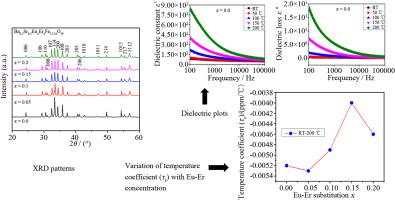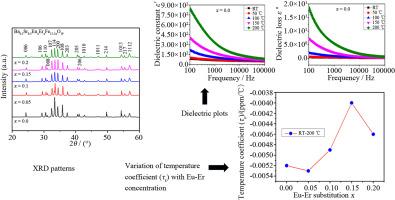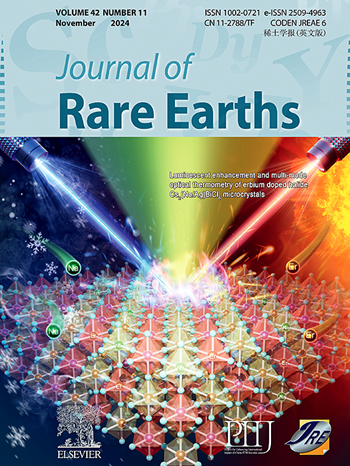Effect of Eu–Er substitution on structural, optical, dielectric, and electrical properties of Ba0.5Sr0.5EuxErxFe12–2xO19 hexaferrite
IF 7.2
1区 化学
Q1 CHEMISTRY, APPLIED
引用次数: 0
Abstract
The present work reports the structural, optical, dielectric, and electrical properties of Eu–Er substituted M-type Ba0.5Sr0.5EuxErxFe12–2xO19 (x = 0, 0.05, 0.1, 0.15, and 0.2) hexaferrites synthesized by sol–gel combustion method. The hexagonal structure of the Ba0.5Sr0.5EuxErxFe12–2xO19 samples was confirmed from X-ray diffraction (XRD) analysis. The values of lattice parameters of the Ba0.5Sr0.5EuxErxFe12–2xO19 samples are increased as compared to Ba0.5Sr0.5Fe12O19 sample. This increase in the value of lattice parameters is attributed to the substitution of larger cations (Eu3+ and Er3+) in place of smaller cations (Fe3+ ions). The crystallite sizes of the Ba0.5Sr0.5EuxErxFe12–2xO19 samples also increase due to the substitution of larger cations. The force constants (Ko and Kt) increases with increasing Eu–Er concentration. The octahedral cluster shifts towards the higher wavenumber side whereas the tetrahedral cluster shifts towards the lower wavenumber side due to Eu–Er substitution in the Fourier transform infrared (FTIR) spectra. The photoluminescence (PL) emission spectra for the Ba0.5Sr0.5EuxErxFe12–2xO19 samples are observed at 365 nm. The dielectric dispersion in the Ba0.5Sr0.5EuxErxFe12–2xO19 samples can be understood by Koop's theory and Maxwell–Wagner type of interfacial polarization. Using Jonscher's power law and the correlated barrier hopping (CBH) model, the frequency and temperature-dependent behaviour of ac conductivity of Ba0.5Sr0.5EuxErxFe12–2xO19 samples are described. The temperature-dependent behaviour of the dc conductivity of the Ba0.5Sr0.5EuxErxFe12–2xO19 samples is explained by the variable range hopping (VRH) model. The Motto temperature of the sample varies from 4.55 109 to 2.31 108 K. The estimated maximum barrier height (WM) of the compound varies from 0.6603 to 0.1199 eV. The temperature coefficient and activation energy of the samples were also calculated as a function of Eu–Er concentration.


Eu-Er 取代对 Ba0.5Sr0.5EuxErxFe12-2xO19 六价铁氧体的结构、光学、介电和电学特性的影响
本研究报告了采用溶胶-凝胶燃烧法合成的 Eu-Er 取代 M 型 Ba0.5Sr0.5EuxErxFe12-2xO19 (x = 0、0.05、0.1、0.15 和 0.2)六铁氧体的结构、光学、介电和电学特性。X 射线衍射(XRD)分析证实了 Ba0.5Sr0.5EuxErxFe12-2xO19 样品的六方结构。与 Ba0.5Sr0.5Fe12O19 样品相比,Ba0.5Sr0.5EuxErxFe12-2xO19 样品的晶格参数值有所增加。晶格参数值的增加是由于大阳离子(Eu3+ 和 Er3+)取代了小阳离子(Fe3+ 离子)。Ba0.5Sr0.5EuxErxFe12-2xO19 样品的晶粒尺寸也因较大阳离子的替代而增大。力常数(Ko 和 Kt)随着 Eu-Er 浓度的增加而增大。在傅立叶变换红外光谱(FTIR)中,由于 Eu-Er 的替代,八面体簇群向高波长一侧移动,而四面体簇群则向低波长一侧移动。在 365 纳米波长处观察到 Ba0.5Sr0.5EuxErxFe12-2xO19 样品的光致发光(PL)发射光谱。Ba0.5Sr0.5EuxErxFe12-2xO19 样品中的介电色散可以用 Koop 理论和 Maxwell-Wagner 型界面极化来理解。利用 Jonscher 的幂律和相关势垒跳变(CBH)模型,描述了 Ba0.5Sr0.5EuxErxFe12-2xO19 样品的交流电导率随频率和温度变化的特性。变程跳变(VRH)模型解释了 Ba0.5Sr0.5EuxErxFe12-2xO19 样品的直流电导率随温度变化的特性。样品的莫托温度从 4.55 × 109 到 2.31 × 108 K 不等。化合物的估计最大势垒高度(WM)从 0.6603 到 0.1199 eV 不等。此外,还计算了样品的温度系数和活化能与 Eu-Er 浓度的函数关系。
本文章由计算机程序翻译,如有差异,请以英文原文为准。
求助全文
约1分钟内获得全文
求助全文
来源期刊

Journal of Rare Earths
化学-应用化学
CiteScore
8.70
自引率
14.30%
发文量
374
审稿时长
1.7 months
期刊介绍:
The Journal of Rare Earths reports studies on the 17 rare earth elements. It is a unique English-language learned journal that publishes works on various aspects of basic theory and applied science in the field of rare earths (RE). The journal accepts original high-quality original research papers and review articles with inventive content, and complete experimental data. It represents high academic standards and new progress in the RE field. Due to the advantage of abundant RE resources of China, the research on RE develops very actively, and papers on the latest progress in this field emerge every year. It is not only an important resource in which technicians publish and obtain their latest research results on RE, but also an important way of reflecting the updated progress in RE research field.
The Journal of Rare Earths covers all research and application of RE rare earths including spectroscopy, luminescence and phosphors, rare earth catalysis, magnetism and magnetic materials, advanced rare earth materials, RE chemistry & hydrometallurgy, RE metallography & pyrometallurgy, RE new materials, RE solid state physics & solid state chemistry, rare earth applications, RE analysis & test, RE geology & ore dressing, etc.
 求助内容:
求助内容: 应助结果提醒方式:
应助结果提醒方式:


